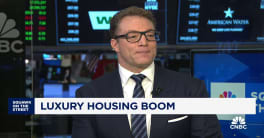News hasn’t been stellar this morning but markets are nonetheless recovering from the global sell-off yesterday. Three hours into the session, the S&P 500 has rebounded 1.05% to 990 (after tumbling 2.4% yesterday), while the Nasdaq has climbed 1.25% to 1,955, and the Dow has moved 0.92% higher to 9,217.
In earnings, Home Depot and Target each saw profits fall due to weakened demand, but cost cutting allowed both companies to beat analyst estimates. Home Depot said second quarter earnings fell 7.2% as sales slid more than 9%, but the nation’s largest home-improvement retailer also boosted its profit forecast for the remainder of the year.
Target’s earnings fell 6.4% to mark its eighth consecutive quarterly decline. Subtracting further from weak sales, softness in its credit-card business hurt revenue, and looking ahead the discount retailer raised provisions for bad debt.
Macroeconomic data was no more supportive this morning. Tame inflation in the Producer Price Index is helpful to producers but is also indicative of weak demand.
Total PPI fell 0.9% in the month, triple what the market was expecting, as food prices fell 1.5% in the month and the energy index sunk 2.4%. In June, food prices had advanced 1.1% and energy prices has surged 6.6%.
Core PPI, which strips out those volatile components, slipped 0.1% in July, mirroring the consensus call that it would increase by the same amount. That’s good news, as core prices have advanced 2.6% over the past 12 months, while total PPI has fallen 6.4%.
Analysts at IHS Global Insight said “broad-based downward pressure on producer prices right through the production pipeline ― in conjunction with persistent downward pressure on wages and salaries and shrinking credit availability ― are signals that deflationary risks to the economy have not been completely put to bed.”
Released at the same time, the Housing Starts & Building Permits put a stop to two months of increases.
Privately-owned housing starts fell 1% to an annual pace of 581,000 in July, against expectations that they would advance 2.3% to 598k. Meanwhile, building permits fell 1.8% to an annualized pace of 560k in June, which is 39.4% below the July 2008 level.
However, the most important component continued on its upward path, as single-family housing starts climbed 1.7% to a rate of 490k ― its highest level since October 2008. So, as with last month, it was multiple-family units that declined, falling 13.3% to 91k in the month after a 26.1% decline in June, putting the index back at April’s level. The trend was similar for building permits.
“Despite the mild pullback in July starts, the housing market remains on the road to recovery due to good affordability,” said Sal Guatieri from BMO. “However, it’s probably relegated to the slow lane until joblessness and credit standards ease.”
The housing market will be easier to interpret by the end of the week, as the index tracking existing home sales is released on Friday.







